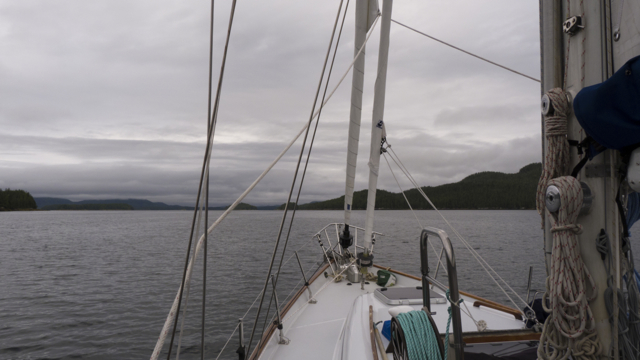19-20 July 2012, Klemtu Anchorage (Clothes Bay)
Marike Muses
Anchored in Klemtu Anchorage, a mile south of the public wharves.
It rained all afternoon.
At 13h00 Zulu, we left No Name. That was morning where we were.
Zulu time so we know when to sign on to the radio. When to communicate.
Zulu time: we count as Greenwich does. Oh England, even here.
Troup Passage. We take the outside route
and find ourselves in slop.
We need more wind to sail. That little schooner out there is just treading water.
We won’t go outside through Milbanke Sound. Instead
we’ll cut through Mathieson. Lots of options in these waters.
Suddenly a blow, a brief reach on, then more slop.
She starts the engine with a pang. I am cheating. I really am cheating here.
Up Mathieson Channel. Where would it lead if we followed it? To Fiordland? Or some other Inlet? All of these Inlets and never any Outlets. No wonder there are serial killers in B.C.
Should we cut across the Jackson Passage? No too shallow. This guide we’re using was written by a damn stink-potter, draft 3 feet. Our keel: 7 feet. Should not risk it. We might on the way back though.
Instead, we choose–she keeps wanting to say “Goat,” but it’s “Oscar”–Passage
from Mathieson Channel to Finlayson. Finlayson is wide. The swell swells in from the Sound.
We look close when the broad sea surges; the hull rises. A moment of vertigo, leap in the gut, like when an elevator shoots up too quickly, then suddenly stops. How many floors did the World Trade Center have? Who remembers? No way to answer that question now.
But if you want to know what that black-hooded gull there is, my mate will tell you: “It’s a Bonaparte gull: a small, agile gull, likened to a tern.” She has the guides to prove it. As we ghost along, she reads about its migration patterns, when it mates, what it eats.
Now we really are socked in. Rain and fog.
Elisabeth, our deaf admiral, who often tunes out, surprises us by noticing. “What’s that off to starboard?” A shiny smooth back. Rolls. Then tail flukes. She sounds. Bye. A small humpback. So close we could hear her breathe.
Time to douse the main. Wouldn’t you know it. Now we have a sailing wind. 20 knots.
I stand at the mast on deck. Trying to train the cardboard thick Dacron of our new main. Obedience school for sails.
“Nose to wind!” “Nose to wind!”
But the helmswoman cannot nail it and the leech bunches up in the lazy jacks.
Now I’ll have to grow to eight feet tall to flatten the monster so it can be stowed!
I start to swear. I am more and more soaked in the rain. Suddenly
“Whoooshhh” and off to starboard, arm’s length from the hull, the humpback rolls to show her eye. Then there’s her entire body, the knobby top of her head. What are those knobs about anyway? Finally the goodbye flukes.
That humpback came to mock my bad humour. What after all, is a little water?
Klemtu means “a place to tie up.”
Inside Klemtu Passage we are buzzed by a landing float plane.
Dangerous place in the fog.
The tug called “Western Titan” doesn’t follow us there, but into Tolmie Channel. As it turns, the tug posts a securité.” How wonderful these quiet waters where captains believe they must still pay heed.
At anchor in Klemtu Anchorage, we eat the rest of our Dungeness crab. A farewell from our shepherds. We earned our independence today. Fear. Insomnia. Determination. Relief.
The rain lets up. The fog remains.
We drop crab shells into the bay, but they sink too fast for Raven or Eagle to snatch, though both are waiting on their silver snags. They let us know their discontent.
“Squeeeek squeeek” complains Eagle, wailing like a rusty clothesline.
“Crawww crawww” mocks Raven.
“KCracck KKracckk” interrupts Heron.
I try jigging for what chases smolts into the air. One jig brings up an empty line.
“My hoochie fell off!” I did not tie it right.
Now Eagle puts her head under her wing: “This could take a long time.”
I give up too. Stow the rod on the stern.
Mate addresses Raven squawking in the tree:
“I know the bits of crab we tossed had no flesh on them. You wouldn’t have left more yourself.”
Raven settles.
Then Mate speaks to Eagle:
“I am sorry about the fishing. We’re bad at it.”
We think we know this Eagle is she because she’s big. The big ones are the girls. Or so we’ve been told.









